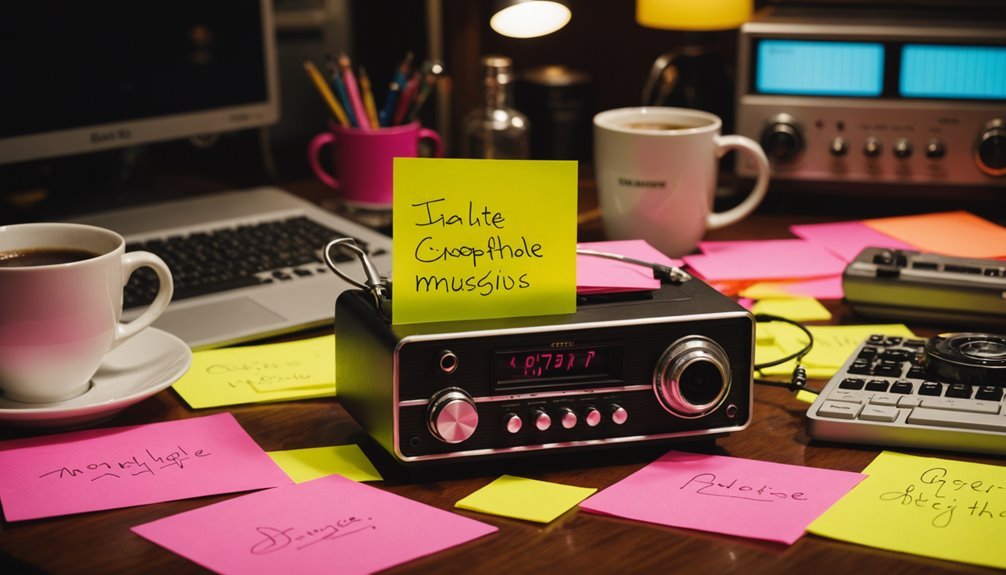Ever had your competitor’s jinglestuck in your head? That’s not a mistake. Jingles are made with innovative marketing and brain science. Simple tunes with repeatable words stick in your memory. Think of lines like “Like a Good Neighbor” or “The Best Part of Waking Up…” Your brain loves patterns, and those patterns help people remember brands.
Jingles can win the branding game by building trust, sparking emotion, and keeping your business top-of-mind. When done right, a jingle becomes more than music—it becomes part of your customer’s daily life. That’s the power of sonic branding.
A professional jingle often pays for itself over and over and over again. Jingles can win the branding game by creating lasting impressions and stronger customer connections. I’m here to help you make that kind of impact.
Key Takeaways: Jingle Marketing Secrets to Strengthen Brand RecallKey Takeaways
- Competitor jingles stick due to their simple, repetitive structures, which are designed for effortless mental retention.
- Unresolved melodies exploit the Zeigarnik effect, looping endlessly in your mind.
- Emotional hooks in jingles create strong, subconscious brand connections.
- Sonic branding crafts memorable auditory identities that resonate deeply.
- Repetition and predictability in jingles enhance recall and familiarity.
The Science Behind Catchy Tunes
A relentless earworm, that fragment of a tune looping endlessly in the mind, is no accident but a calculated product of neuroscience and psychology. Crafted with precision, catchy jingles exploit musical patterns—simple, repetitive structures that the brain clings to effortlessly. These unresolved melodies trigger the Zeigarnik effect, compelling the mind to loop until completion, securing a spot in collective memory.
Jingles are indispensable assets in advertising, emphasizing their importance in marketing.
Through strategic cognitive processing, the brain prioritizes these tunes, favoring predictable rhythms and minimal variation for subconscious retention. This isn’t random; it’s a shared experience, a hook that binds listeners to a familiar soundscape. By understanding this science, one joins a savvy circle that sees beyond mere noise, recognizing the power of crafted melodies to linger and unite.
Repetition plays a crucial role in this process, as it enhances familiarity and recall effortlessly.
Emotional Hooks That Drive Behavior
Resonance lies at the heart of why certain jingles and campaigns burrow deep into the psyche, steering behavior with surgical precision. Affective triggers are the linchpin, tapping into the core of consumer behavior with staggering impact. Data reveals that affective campaigns boast a 31% success rate, doubling the success rate of rational ads, while 90% of decisions hinge on feelings over logic.
Brands that wield empathy forge stronger bonds, as 77% of consumers crave connection during key purchasing decisions. Audio branding creates a unique sonic identity that enhances this emotional connection, further driving consumer engagement.
These strategies aren’t fleeting; profits from effective ads surge from 13% to 43% over three years, cementing loyalty. By aligning with individual desires, brands become an integral part of our shared story, driving purchases and fostering advocacy. Emotional marketing also fosters long-term customer retention, ensuring sustained engagement over time. Affective hooks don’t just sell—they build a tribe where everyone belongs.
Memory Tricks for Lasting Impact

While sincere hooks forge deep connections, the staying power of a competitor’s jingle often hinges on sophisticated memory tricks designed for lasting impact. These memory techniques tap into the brain’s ability to retain auditory patterns, ensuring a tune lingers long after it has been heard. Studies reveal that melodies outperform lyrics in recall, exploiting familiar structures through repeated exposure to create neural anchors.
Concise jingles, lasting 10–30 seconds, optimize encoding before cognitive overload, while cross-modal associations with visuals strengthen retention. For a community craving connection, aligning with these strategic auditory patterns feels instinctive, almost like joining a shared rhythm. Music’s unique ability to evoke emotions enhances its role in memory, as it activates personal and cultural associations that tie brands to specific experiences, evoking emotions.
Furthermore, catchy jingles play a crucial role in enhancing visibility in the digital era, forging connections that evoke memories and strengthen audience relationships with brands. Yet, misuse or overplay risks fatigue, underscoring the need for balance in crafting jingles that resonate within our collective memory.
Building Bonds Through Sound
Observers note that, beyond mere memorability, sound serves as a powerful conduit for forging genuine connections between brands and their audiences. Sonic branding crafts an auditory identity that resonates profoundly, embedding brands into the collective psyche through sentimental resonance. Music in advertisements triggers pleasure and reward centers, building unspoken bonds that make consumers feel part of a shared story.
Strategically, integrating cultural relevance into jingles amplifies this connection by aligning melodies with local traditions or nostalgic eras, thereby evoking a sense of belonging. Such tailored auditory experiences guarantee that brands become familiar voices in diverse communities. By prioritizing heartfelt and cultural alignment, companies transform mere sounds into lasting relationships, inviting audiences to feel at home with every note they hear.
Furthermore, advertisers understand that utilizing strong sensory stimuli, such as music, can create a significant emotional impact on memory retention, ensuring brands remain top-of-mind during consumer decision-making. Additionally, auditory cues process faster than visual stimuli, making sound a powerful branding tool that enhances overall consumer engagement.
Evolving Strategies for Today’s Market
 Navigating the ever-shifting landscape of consumer preferences, brands are adopting creative strategies to ensure their jingles remain impactful in today’s market. By leveraging nostalgia and data-driven insights, they craft melodies that resonate across generations, blending familiar tunes with modern twists to foster a sense of belonging. Jingle innovation is key—AI tools and predictive analytics enable rapid testing and adaptation, ensuring sentimental impact and platform consistency.
Navigating the ever-shifting landscape of consumer preferences, brands are adopting creative strategies to ensure their jingles remain impactful in today’s market. By leveraging nostalgia and data-driven insights, they craft melodies that resonate across generations, blending familiar tunes with modern twists to foster a sense of belonging. Jingle innovation is key—AI tools and predictive analytics enable rapid testing and adaptation, ensuring sentimental impact and platform consistency.
Meanwhile, brand alignment with audience values and music trends, as seen in McDonald’s positivity or Maybelline’s updated classics, builds lasting connections. Collaborating with creative agencies like Killerspots ensures that jingles are not only catchy but also strategically impactful. Effective jingles influence purchasing decisions by creating emotional connections that drive consumer loyalty.
Cross-platform integration, from TikTok challenges to radio, amplifies reach, making jingles sonic anchors of identity. In this competitive space, strategic evolution ensures that brands remain memorable, inviting consumers into a shared, harmonious community.
Frequently Asked Questions
How Can I Stop a Jingle From Replaying in My Mind?
To halt a jingle replaying in one’s mind, employ mind distraction techniques, such as engaging in complex tasks or activities. Join others in using jingle avoidance methods, such as ambient sounds, strategically breaking mental loops for shared relief.
How can a jingle win the branding game for your business?
A catchy tune helps people remember your brand, feel good about it, and choose you when it’s time to buy. It’s an innovative, lasting way to stay top-of-mind.
Are Jingles Effective Across All Age Groups Equally?
Imagine a melody weaving through diverse minds, yet its grip varies. Jingles aren’t uniformly effective across all age preferences; jingle retention hinges on nostalgia and platform, strategically uniting generations seeking shared auditory connections.
Do Jingles Work Differently in Various Cultural Contexts?
Jingles indeed work differently across cultural contexts, reflecting cultural significance in melodies and rhythms. Strategic adaptation, considering linguistic nuances, fosters a sense of belonging by aligning with local traditions, ensuring resonance, and avoiding alienation in diverse markets.
Can Jingles Negatively Impact Brand Perception Sometimes?
Like a discordant melody, jingles can sometimes jar the senses, forming negative associations that erode brand loyalty. Strategically, poorly crafted or overplayed tunes alienate audiences, fracturing the connection communities crave with trusted brands.
Why Do Some Jingles Annoy Instead of Attract?
Some jingles annoy instead of attract due to jingle psychology, which exploits overexposure and mismatched cultural cues, thereby fostering brand annoyance. This alienates listeners, disrupting the sense of belonging that brands aim to build strategically.
Conclusion
Jingles can play a role in the branding game because they stick in people’s minds long after the music stops. A great jingle is more than just a tune—it’s a powerful tool that connects your brand to feelings and memories. This makes your business easier to remember and more trusted by customers.
Audio branding works like magic. When done right, it creates a strong bond between your brand and your audience. That connection fosters loyalty and encourages people to return.
As a professional jingle writer, I know that a bright, catchy jingle pays for itself again and again. If you want your brand to stand out and be unforgettable, let’s make a tune that wins.
References
- https://blog.killerspots.com/the-science-behind-catchy-jingles/
- https://scoreascore.com/blog/8-reasons-why-jingles-are-powerful-in-advertising/
- https://thejinglewriter.com/psychology-of-sound/
- https://www.insidehook.com/culture/music-psychology-commercial-jingles-earworms
- https://thejinglewriter.com/the-power-of-jingles/
- https://blog.killerspots.com/the-science-behind-jingles/
- https://themystickeys.com/why-do-some-songs-get-stuck-in-your-head-catchy-music-science/
- https://www.spiralytics.com/blog/statistics-prove-emotional-marketing-works/
- https://embryo.com/blog/emotion-in-marketing-stats/
- https://system1group.com/blog/emotions-key-role-in-digital-ad-effectiveness

Cary Reich is a master jingle-writer with over 35 years of experience creating brand‐defining melodic slogans and audio identities. Since 1985, Cary has crafted memorable campaigns for both national and local clients — including Budweiser, Firestone, Gold’s Gym, Goodwill, and YMCA — blending creative vision and musical expertise to make businesses not just heard, but remembered.

